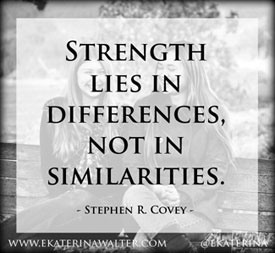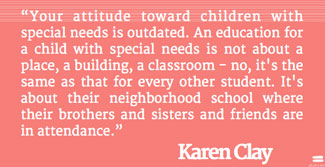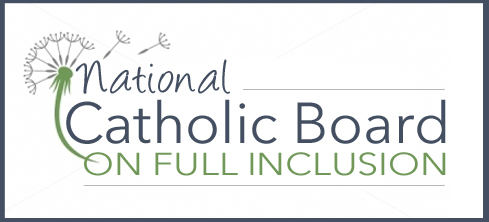The Promise of Inclusive Education
Inclusive education brings all students together in one classroom and community, regardless of their strengths or weaknesses in any area, and seeks to maximize the potential of all students.

• Inclusion is an effort to make sure that diverse learners – those with disabilities, different languages and cultures, different homes and family lives, different interests and ways of learning – are exposed to teaching strategies that reach them as individual learners
• Inclusive schools ask teachers to provide appropriate individualized supports and services to all students without the stigmatization that comes with separation
• Teachers in inclusive classrooms vary their styles to enhance learning for all students
About Inclusive Education
The purpose of education is to ensure that all students gain access to knowledge, skills, and information that will prepare them to contribute to America’s communities and workplaces. The central purpose becomes more challenging as schools accommodate students with increasingly diverse backgrounds and abilities. As we strive to meet these challenges, the involvement and cooperation of educators, parents, and community leaders is vital for the creation of better and more inclusive schools.

- What is inclusion? —— Inclusion is an educational approach and philosophy that provides all students with community membership and greater opportunities for academic and social achievement. Inclusion is about making sure that each and every student feels welcome and that their unique needs and learning styles are attended to and valued. Inclusive schools put the values upon which America was founded (pluralism, tolerance, and equality) into action; they ask teachers to provide appropriate individualized supports and services to all students without the stigmatization that comes with separation. Research shows that most students learn and perform better when exposed to the richness of the general education curriculum, as long as the appropriate strategies and accommodations are in place. At no time does inclusion require the classroom curriculum, or the academic expectations, to be watered down. On the contrary, inclusion enhances learning for students, both with and without special needs. Students learn, and use their learning differently; the goal is to provide all students with the instruction they need to succeed as learners and achieve high standards, alongside their friends and neighbors.
- Is inclusion the same as mainstreaming? —— No. Proponents of mainstreaming hold that students with special needs be placed in the general education setting solely when they can meet traditional academic expectations with minimal assistance. Yet, simply placing students with special needs in the regular classroom is not enough to impact learning. Teachers in inclusive schools are asked to vary their teaching styles to meet the diverse learning styles of a diverse population of students. Only then can the individual needs of all our students be met. Schools of the future need to ensure that each student receives the individual attention, accommodations, and supports that will result in meaningful learning.
- Why isn’t inclusive education the norm in our schools? —— Many years ago, special classes were created for students with special needs. Special educators felt that if they could just teach these students separately, in smaller groups, they could help them to catch up. However, the reality is that students in segregated special education classes have fallen further and further behind. Over time, we have learned that inclusive education is a better way to help all students succeed.
- How can our schools be transformed? —— The extent to which professional educators, families, and community leaders enter into a discussion on how to improve education for all our students holds the promise for the transformation of American schools from a 20th century educational system, dominated by a narrow cultural perspective, to one that reflects and values the multicultural and diverse nation that is the United States today. You can make the difference by becoming involved!
A Brief History of Inclusion
Today it is widely accepted that inclusion maximizes the potential of the vast majority of students, ensures their rights, and is the preferred educational approach for the 21st century. Unfortunately, the philosophy has not always been widely held. Our thinking and acceptance has evolved rapidly over the last century, and continues to evolve, in response to federal and state law, along with our changing social and political beliefs.
 Think back. When compulsory public education began near the turn of the century, no public school programs existed for students with disabilities. Schools were expected to be efficient assembly lines, with each class of students moving from grade to grade and, eventually, graduating from high school as productive citizens prepared to enter the workforce. Special classes, at first, did not exist. Later, they were developed as a place for students who could not meet the standards and keep pace with fellow classmates.
Think back. When compulsory public education began near the turn of the century, no public school programs existed for students with disabilities. Schools were expected to be efficient assembly lines, with each class of students moving from grade to grade and, eventually, graduating from high school as productive citizens prepared to enter the workforce. Special classes, at first, did not exist. Later, they were developed as a place for students who could not meet the standards and keep pace with fellow classmates.
By the 1950s, special education public programs were available in many school districts, but some undesirable outcomes were becoming apparent. Many authorities in the field agreed that segregated special classes were not an appropriate educational setting for most students with special needs, for it was clear that educating students with special needs in isolated settings minimized, rather than maximized, their potential.
Simultaneously, the Civil Rights Movement was in its great surge, and the fights for equal rights and non-discriminatory laws were being culminated in the U.S. Supreme Court with the historic Brown Decision. In 1954, the case of Brown vs. the Board of Education established the principle that school segregation denies students equal educational opportunity. Although the decision referred to racial segregation, it began to influence our thinking about people with disabilities. The thinking went something like this: if separate is not equal, what about our children with special needs being denied the right to a free and public education, or being placed in separate, segregated, classrooms?
One of the outcomes of the Civil Rights Movement is the enactment of legislation designed to prevent discrimination against individuals with special needs, whether they are children in schools or adults in the workforce.
 In the early 1970s, landmark civil rights legislation opened the door for all children with special needs to receive a free and public education, and ensured equal opportunity for students to participate in the full range of school activities.
In the early 1970s, landmark civil rights legislation opened the door for all children with special needs to receive a free and public education, and ensured equal opportunity for students to participate in the full range of school activities.
The 1997 reauthorization of the Individuals with Disabilities Education Act (IDEA) specifically supports inclusive thinking and practices. IDEAcalls for involving students with special needs in general education curricula, assessment practices, and classrooms. Recognizing that traditional strategies result in a lack of learning outcomes for students with special needs, relative to outcomes of comparable peers without special education labels, IDEA encourages general and special education teachers to work together for the benefit of each and every student. The Committee Report that accompanied the new law to Congress explains the legislators’ intent: inclusion is a philosophy of acceptance and flexibility.
On January 8, 2002, the No Child Left Behind Act was signed into law. The legislation bolsters the philosophy that the majority of students with special needs be moved out of segregated classrooms, and given the appropriate strategies, accommodations, and teaching styles to match their unique learning styles. The No Child Left Behind Act builds on four principles for education reform: accountability for results, doing what works based on scientific research, expanded parent options, and expanded local control and flexibility.
 At a fundamental level, inclusion is really about fairness. Responding to each student based on need is the meaning of fairness. In the past schools could hide achievement results by excluding students with special needs. This is no longer possible. No Child Left Behind has changed the landscape of education by shifting the focus from compliance to outcome; it requires us to measure the progress of all our students so that every child can realize the great promise of America.
At a fundamental level, inclusion is really about fairness. Responding to each student based on need is the meaning of fairness. In the past schools could hide achievement results by excluding students with special needs. This is no longer possible. No Child Left Behind has changed the landscape of education by shifting the focus from compliance to outcome; it requires us to measure the progress of all our students so that every child can realize the great promise of America.
On Inclusion and the Other Kids
Inclusion is receiving considerable attention, both in school districts across the country and in the popular media. Most of the attention is focused on how inclusion affects the students with special needs. But what about the students who don’t have special needs?
- Will the learning of students without special needs suffer because of inclusion? Thirty years of educational research has shown time and time again that not only is there no slowdown in the learning of children without special needs in inclusive classrooms, often there is improvement in learning outcomes across the entire group of learners. Additionally, surveys conducted with parents and teachers involved in inclusive settings show that they have positive opinions about inclusion.
- The glass is half full So in a nutshell, the research conducted thus far shows that being in an inclusive classroom doesn’t hurt the students without special needs. But does it help them? The growing body of research suggests that students without special needs can gain a number of important benefits from relationships with their classmates who have special needs. Some of the benefits include: friendships, social skills, personal principles, comfort level with people who have special needs, and caring classroom environments.
- Friendships The most important function of friendships is to make people feel cared for, loved, and safe. Researchers have documented cases of long-lasting friendships that have emerged between students who have special needs and typical students, in which both students benefit. Recent research has helped to identify three specific areas of mutual benefit for children with and without special needs who are friends with each other: (1) warm and caring companionship; (2) growth in social cognition and self-concept; and (3) the development of personal principles. Of course, inclusive settings do not mean that all typical children become close friends with children who have special needs. However, even when relationships remain at the level of ‘classmate’ or ‘familiar acquaintance’, versions of these same benefits have been reported in surveys of teachers and other research.
- Social Skills Children without special needs often can become more aware of the needs of others in inclusive classrooms. As they become skilled at understanding and reacting to the behaviors of their friends with special needs, they gain an enhanced acceptance and appreciation of each child’s unique gifts. Students without special needs grow in their commitment to their own moral and ethical principles and become advocates for their friends who have special needs. The development of strong personal principles will benefit students throughout their lives.
- Comfort Level With People Who Have Special Needs On surveys and in interviews, middle and high school students without special needs say they are less fearful of people who look different or behave differently because they’ve interacted with individuals with special needs. Parents notice the differences in their children, too. An interesting side effect is that these parents report that they, also, feel more comfortable with people with special needs because of their children’s experiences.
- Caring Classroom Environments Schools and classrooms can be structured to facilitate kindness, consideration, empathy, and compassion for others. Within a caring classroom environment, students have opportunities to learn about their classmates in ways that honor the full range of experiences that each child brings to the classroom.
Inclusive Classroom Practices
As general education classrooms include more and more diverse students, teachers realize the value of accepting each student as unique. Special educators understand that effective general education practices really are appropriate for students with special needs, and general educators often turn to special educators for additional ways to teach their increasingly diverse groups of students.
Some of the specific classroom practices recommended in national reports are:
- LESS whole-class, teacher-directed instruction
- LESS student passivity
- LESS prizing and rewarding of silence in the classroom
- LESS classroom time devoted to fill-in-the-blank worksheets, dittos, workbooks, and other “seatwork”
- LESS student time spent reading textbooks and basal readers
- LESS effort by teachers to thinly “cover” large amounts of material
- LESS rote memorization of facts and details
- LESS stress on competition and grades
- LESS use of pull-out special programs
- LESS use of and reliance on standardized tests
- MORE experimental, inductive, hands-on learning
- MORE active learning
- MORE enacting and modeling the principles of democracy in school
- MORE choice for students
- MORE time devoted to reading full, original, books
- MORE deep study of a smaller number of topics
- MORE emphasis on higher order thinking skills when learning key concepts and principles of a subject
- MORE cooperative and collaborative activity
- MORE delivery of special help to students in general education classrooms
- MORE varied and cooperative roles for teachers, parents, administrators, and community members when teaching and evaluating student performance




